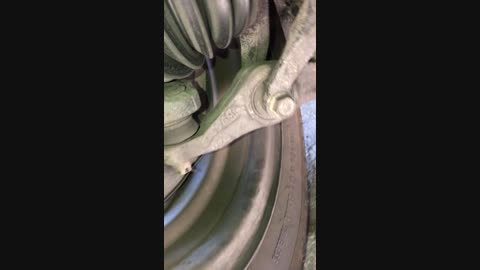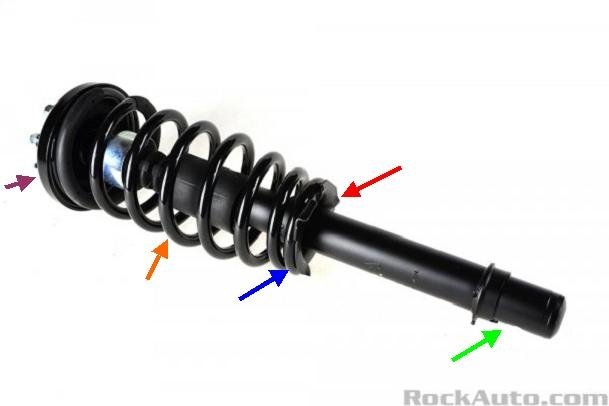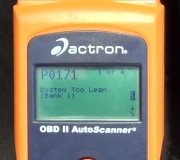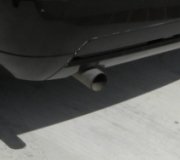Hold on. Your mechanic obviously was never a student in caradiodoc's School of Automotive Knowledge and Repair Emporium! Ride height, which you observed is obviously not correct, is set by the springs. Tie rod ends only are part of the steering linkage for the two front wheels. They have absolutely nothing to do with ride height; only which way the wheels are steering.
A bent control arm does not affect ride height, at least not very much, unless it is bent into a pretzel. The forces holding up the front corner of the car start at the road surface, go up through the tire, the wheel, the wheel bearing, spindle, lower half of the strut body, the coil spring, the upper strut mount, then into the body. The coil spring pushes down on the spindle which is attached to the wheel and tire. There is a modified version of that design where the bottom of the strut is attached to and pushes down on the lower control arm, then the forces continue on through the lower ball joint, then into the spindle. Even with this design, ride height will change very little, certainly not enough to be noticed by eye, if the control arm is badly bent. If the arm is bent, the main problem will be it is no longer holding the bottom of the wheel in place, which means the alignment numbers on the computer screen will be incorrect. Where the tire makes contact with the road surface will be moved closer to the center of the car, or forward or backward a little.
Without getting into all kinds of exciting theory, ride height must be exactly as specified by the manufacturer to obtain best handling, tire wear, steering response, comfort, and shortest stopping distance. All tire and alignment shops have small books that list every car model and year, what the front and rear height specs are, and where to take those measurements. All newer alignment computers also have provisions for measuring ride height so it can be included on the printout for proof it is within specs, but some are only concerned that it be equal on both sides, not necessarily at specs. This was a real big deal in my Suspension and Alignment class, and it's a real big deal to experienced alignment specialists. Professionals will not even take your money for an alignment unless they are allowed to correct ride height first. It is also a real big issue with lawyers and insurance investigators. They love to find lowered cars and raised trucks on the other guy's car when it is their client that caused the crash. They will convince a jury that due to the altered ride height, you were less able to avoid the crash, and they will be right. That shifts some of the blame onto you even though it was their client who ran the red light.
Your mechanic was wrong on a number of issues. He apparently does not understand what affects ride height or how to correct it. He should never have attempted to align your car until ride height was fixed, and he should never have accepted the results that the car still leaned and still pulled after the service he charged you for. You would not pay for a haircut if your new, inexperienced barber did not know how to turn on an electric razor. You would not pay for a loaf of bread that was only half-baked. What did you get for your alignment dollars? You paid to have the lean and the pull corrected, and you still have a lean and a pull.
Besides bent parts, there are three main things to look for when ride height is not at specs. The most common cause by far is weak springs. This, and the fact that replacing them is a dangerous and time-consuming job, is why all the better aftermarket suspension parts manufacturers offer "quick struts" which are new struts with new springs and other hardware already installed. Replacing a pair of struts this way requires no special tools, and can be done in a matter of minutes. The car does still need to be aligned after that service. This type of strut is the best choice when the car already needs new struts, and it is old enough that the coil springs have sagged from age. Their higher cost is offset by the much shorter time required to do the work.
The second cause of low ride height is a broken coil spring. They all have a painted coating to prevent rust, but that flakes off over time. Most commonly they break near the lowest loop of the spring, I suspect because it sits on a plate welded to the strut body, and dirt, salt, and water collect there. Typically when it breaks there, you will not notice it until it shows up with the ride height measurements performed by your mechanic. You have to feel with your fingertips to find a break near the lower mounting plate, but do so very carefully. Any time a coil spring breaks, it does so by leaving very sharp points on the ends, and it is easy to cut your fingers.
Sometimes a spring will beak closer to its center, and it is not uncommon for a sharp end to puncture the sidewall of the tire. Even if that does not happen, you will feel the harsh bouncing over bumpy roads. There will not be any give, or movement, when you push down on the corner of the car because it is already sitting as low as it can go.
The least common cause is that lower plate on the strut body rusts away, then breaks loose. That plate is holding all the weight on that corner of the car, which can be well over 1,000 pounds. This failure can happen on any brand of car, but it seems to be more common on Hondas.
Here is two photos that show the front strut for your car. The green arrows are pointing to the lower end that slides into a pocket on the spindle, then it is clamped there. The red arrows are pointing to the steel plate that's welded to the strut body. This is where the coil spring sits, and where it pushes down to hold the car up.
The second photo is of the complete assembly you would get when you buy it with the new spring already installed. The blue arrow is pointing to the lowest loop on the spring where they commonly break. Sometimes you will hear a single, really loud bang when it breaks, but this part of the spring does not contribute very much to ride height, so after that one bang, you may never notice another problem until someone measures ride height. The more dangerous failure is when they break in the area of the orange arrow. This is where a sharp end can go through the tire. The purple arrow is pointing to the upper strut mount. It is a plate that holds the spring compressed when the assembly is removed from the car, and all the car's weight is supported by that mount. There is a bearing in it to allow the strut, wheel, and tire to rotate as an assembly when you turn the steering wheel. Sometimes those get dirt inside the bearings, or they just deteriorate, then they cause roughness, crunching noises, or banging/thumping/twanging noises as you turn the steering wheel. Those noises are almost always only heard when the car is standing still or moving very slowly, as in when backing out of a parking space. Road vibration at higher speeds helps those mounts rotate for steering, so you usually will not notice an issue at those times.
You need to have a second pair of eyes inspect your car. My concern is if the first mechanic did not understand the role of coil springs, what else does he not know how to inspect or what to look for? Are there any safety issues he overlooked. If this was at a one-man shop, or a small shop with just a few employees, look for a different one that specializes in tires and alignments. If you were at a larger shop where you speak with a service writer and not directly with the mechanic, explain that you did not get what you paid for, and the person overlooked the cause of the problem. Normally I would suggest a mechanic deserves the opportunity to check his work and correct his mistakes, but in this case, I would want a more-experienced person to work on my car. Had I done this kind of job at the dealership I worked for, I would be expected to find and solve the cause of the problem, then realign the car, all on my own time at no cost to the shop or to you for the work I had already done. You can be expected to pay for additional parts that were needed all along but you were not charged for yet, but the shop should cover the cost of the second alignment. The people at many shops will go beyond that and give you a discount on the additional labor charges as a way of apologizing that they did not do the job right the first time.
If you did not get a copy of the printout from the alignment computer, ask for one from the second alignment. I always put a copy on the front passenger seat with the items highlighted that I changed or adjusted. If you post those numbers in your reply, I can interpret them for you.
Images (Click to make bigger)
Saturday, May 12th, 2018 AT 6:26 PM






